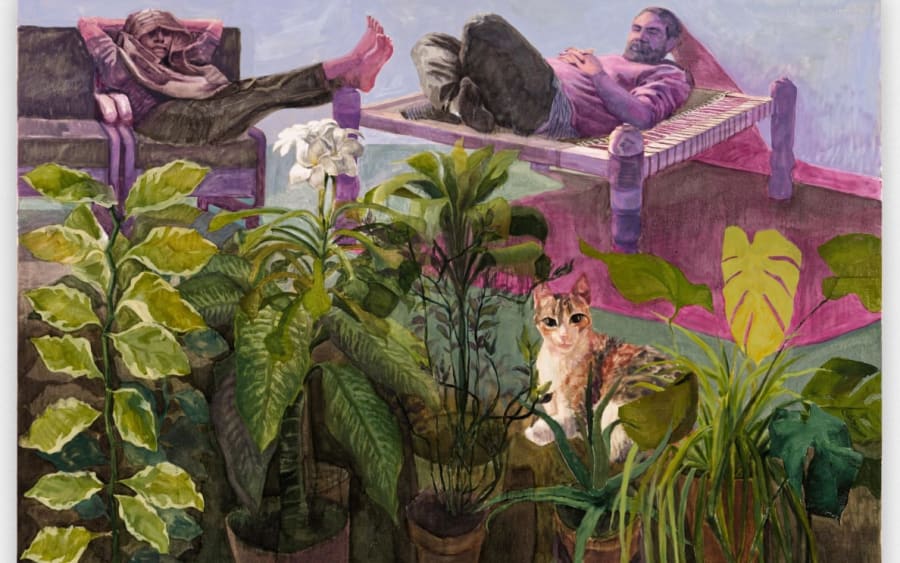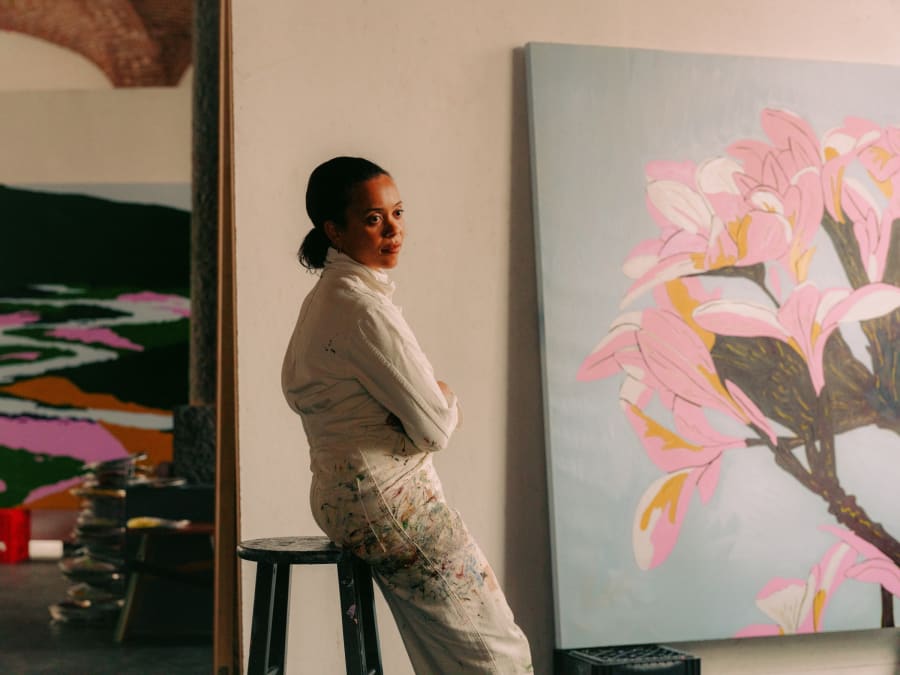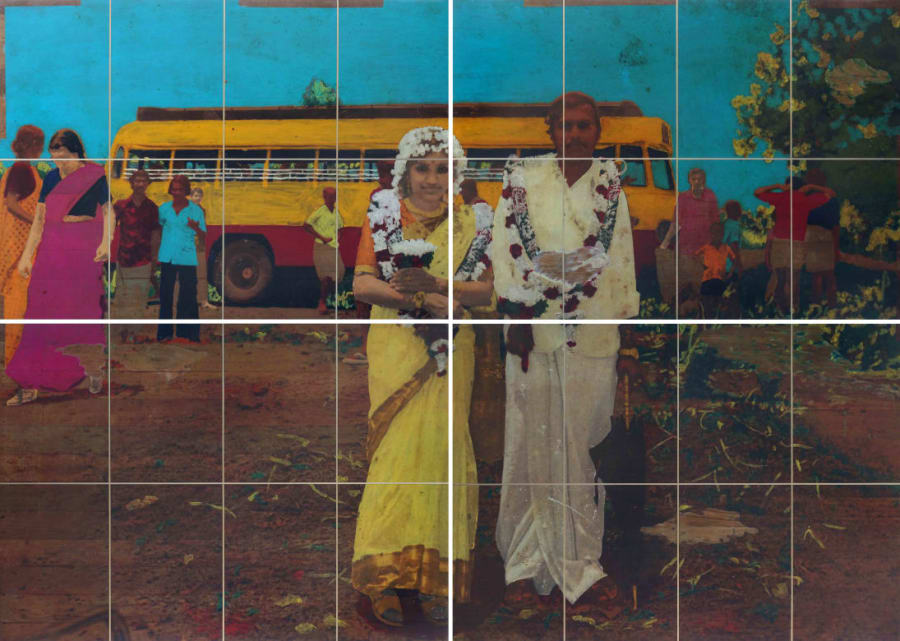An army of Persian cats greets me on my visit to Aisha Khalid and Imran Qureshi’s residence in Lahore. Struggling to get through to the living room, I take in the house’s magnificent 20-foot-high ceiling. This extraordinary domestic space, impeccably furnished and surrounded by dense foliage, is the sanctuary of Pakistan’s preeminent artist couple. They have created this home with passion and dedication, spending 25 years acquiring paintings, craft, and artifacts, to create an exquisite fusion of art, design, and architecture. Theirs is a life of artistic intimacy.
From Diego Rivera and Frida Kahlo to John Lennon and Yoko Ono, artist couples have punctuated art history for decades, if not centuries. But Khalid and Qureshi are different. Together, they form the core of the neo-miniature movement. Both have played – and continue to play – a major role in the development of a new kind of painting tradition. Each in their own way, Khalid and Qureshi have mastered the art of symbolism and brought to the fore the productive potential of linking history and contemporaneity in and beyond South Asia.
The pair first met in 1992 as students at the National College of Arts, Lahore, one of the oldest art institutions in South Asia, and alma mater to many distinguished artists from the region. Both had traveled from smaller towns to study fine arts in Pakistan’s capital city, both studied miniature painting, both were ‘junooni’ (obsessive), curious students with extraordinary energy, and an endless desire and drive to learn. They grew fond of each other. ‘I was in awe of Aisha’s discipline, decorum, and organization,’ remembers Qureshi. ‘I learnt a lot from her.’ Khalid adds, ‘Back then, Imran had a spark like no one else, I admired his ambition and his ability to experiment and take risks.’
Their personal journeys and artistic lives have converged beautifully over the last three decades – and their rich portfolios reflect their shared influences. Inspired by classical Mughal miniatures and the Indo-Persian painting technique of pardaakht (thin, rigorously detailed mark-making), they have expanded its visual vocabulary to encompass a wide variety of media, stretching the boundaries of traditional miniatures beyond the obvious limitations of scale and two-dimensionality to include elements of space, time, and sound. Their distinct imagery and artistic methods center on color and repetition of form, while their large-scale monumental projects exhibit distinct sociopolitical concerns.
Now recognized and exhibited internationally, Khalid can be credited for reconfiguring the ethos of miniature painting. She also works with textiles, video, and site-specific installations in architectural spaces, and is at once an artist, educator, curator, and agriculturalist. Khalid completed her postgraduate studies at the Rijksakademie, Amsterdam in 2002 – an experience she remembers as a steep learning curve. ‘My miniatures were considered beautiful and exotic but beyond that the viewers could not read anything significant in them,’ she recalls. ‘In Pakistan my work was seen as unconventional and modern while Western audiences considered it archaic.’
Khalid is immersed in ideas of gender. The soul and sensibility of her work is often derived from her use of crafts, such as textiles and needlework, traditionally associated with women. The recurring use of the covered or uncovered female figure via motifs such as curtains, burqas, and flowers is also an essential idiom within her visual language. However, her interest in the repetition of forms, combined with floral motifs, is derived from Islamic geometric patterns.
Khalid’s work is deeply inspired by the work of the 13th-century poet Rumi, and rooted in Sufism, with zikir (recital) being a central element in her artistic journey. ‘The process of making art is everything,’ she explains. ‘It has a meditative rhythm that dominates the outcome. While drawing and painting, I feel as if I am a simple tool in the hands of an unseen power.’
Both Khalid and Qureshi are nature and animal lovers. ‘I’ve always had birds and parrots. I used to feed birds on my studio rooftop. In our old, small house, stray cats would often sit outside the entrance door,’ she shares. Qureshi often rescues injured dogs, bringing them home as pets.
Khalid is now turning her own studio spaces into farm land, communal gardens, and new forms of shared agricultural environments that she says will evolve over time. She has planted around 400 trees on almost five acres, where she also grows wheat, rice, mustard, and various vegetables. ‘I was inspired by the Persian garden format,’ she explains, ‘and divided the land into a charbagh (quadrilateral) layout with pathways for walking. Fresh water flows through the farm, enriching its soil.’ Khalid has also added a flock of 25–30 desi (organic) chickens, goats, and sheep. This year, she harvested figs, oranges, guavas, pomegranates, and grapes. ‘This farm is more than just land – it is my lifelong art project. The act of transplanting rice into damp soil feels like piercing steel pins into my tapestries. In spring, the vibrant yellow of mustard flowers and the purple, red, blue, and white shades of the flowering trees and crops become an extension of my soul.’
Qureshi, meanwhile, heads the department of miniature painting at the National College of Arts in Lahore, where he also spearheads extra-curricular festivals every semester with an unmatchable spirit and fervor. Like Khalid, he has been exhibiting locally and internationally for almost thirty years. Collected in major institutions around the world, his work is a blend of 16th-century Mughal motifs and abstraction with luminous splashes of gold leaf and red acrylic paint. He creates symbolic images that allude to the fierceness, vulnerability, and resilience of the human body. ‘My current practice has two strands,’ he says. ‘One is rooted in painting – figurative, abstract, often on monumental scales – that emerges from my training in the miniature painting studio, while the other is based on site-specific intervention, engagement, and a response to the city.’
Deen O Duniya (The Sacred and the Earthly) was Qureshi’s site-specific installation developed for the Karachi Biennale in 2022. It employed neon and LED light structures that are often associated with the heavy embellishments on architectural facades for Rabi’ Al-Awwal, the celebrations marking the birthday of the Prophet Muhammad. ‘The entire city (and the country) operates as my workspace,’ says Qureshi.
‘I enjoy celebrating the mundane in my surroundings by accentuating already existing visual elements, transforming the familiar, and subverting its essence,’ he continues. He explains how, after years of toying with the idea of using the form of a charpai (a woven bed used across South Asia), it finally found its full expression in a large piece commissioned by the Islamic Arts Biennale, which opened in Jeddah, Saudi Arabia, last month. Made of handwoven nylon, the octagonal work spans 450 square meters, enveloping the sand-covered area between the Mecca and Madina pavilions within the biennale’s site. Together, these elements form a garden-like installation, symbolizing an oasis – a place for pause or a stopover between the evocations of two sacred cities.
Khalid and Qureshi’s work and life stand as testament to their boundless energy and dynamism. They are the uncontested pioneers of a new school of thought – the Pakistani ‘neo-miniature’ school – leading a generation of artists, who have re-envisioned and morphed the tradition of miniature painting into an internationally celebrated form of art. Their creative relationship has transcended and enriched the global artistic landscape beyond South Asia. But at its core, it remains anchored to a deeply personal and intimate practice. In Qureshi’s words, ‘Art making is a blessing for me, a survival instinct.’ Khalid echoes, ‘My work is like a prayer.’
Aisha Khalid's work will be presented by Anant Art Gallery (New Dehli) in the Insights sector at Art Basel Hong Kong 2025.
Imran Qureshi is represented by Thaddaeus Ropac (London, Milan, Paris, Salzburg, Seoul), and Nature Morte (New Delhi).
The Islamic Arts Biennial, Jeddah, is on until March 25th, 2025.
Rabeya Jalil is an art educator and visual artist based in Lahore.
Top image: Aisha Khalid and Imran Qureshi in their home in Lahore, February 2025. Photography by Osama Doger for Art Basel.
Published on February 14, 2025.


